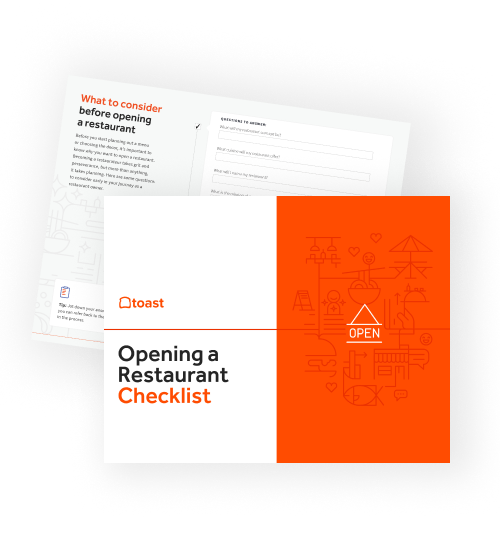
How to Run a Successful Cafe: 8 Running a Cafe Business Tips (2024)
Running a cafe isn’t easy, but with the right people by your side and the right tools and processes, you can build a successful cafe business.

Katherine BoyarskyAuthor


Opening a Restaurant Checklist
So many things go into opening a restaurant. Use this free PDF checklist to set your new restaurant up for success.
Get free downloadHow to Run a Cafe: 8 Running a Cafe Tips
Cafes are the perfect example of the concept of “third place”: a space in a community that isn’t home or work where neighbors can just go relax, connect with one another, get work done, and enjoy some downtime.
Opening a cafe takes a lot of organization and drive, but it can be extremely rewarding. Selling delicious coffee and treats to everyone in the neighborhood, providing a space for creatives and remote workers to find connection, and creating a supportive work environment where staff can learn even more than how to pull the perfect ristretto are all great reasons to get into cafe ownership.
Running a successful cafe in 2022 and beyond takes a lot of work and flexibility, but we’ll get into everything you need to know to optimize every area of your business and set yourself up for success — no matter if you’re a new cafe owner or a longtime neighborhood coffee mogul.
8 Tips for Managing & Optimizing Key Cafe Operations Costs
1. Rent and Overhead
Location is everything when it comes to cafes. Typically, the bulk of your customers will live close to your business, with only a small percentage traveling across the city to try your coffee and pastries. That’s why it’s important to choose a great location for your cafe. Balance how much revenue you’d be able to make in various neighborhoods, figure out how much you’ll be able to spend on overhead (including your location), and choose your perfect cafe space.
But before you sign a lease, double-check that there’s no issues with the price, the fine print, or the landlord. Consider negotiating your lease down a little bit, as you’ll be paying rent every month as long as you’re operating your business, so it’s an important piece of your overhead costs to keep as low as possible. After all, overhead costs include everything you’ll need to pay to operate your business, no matter if you’re super busy or having a slower month.
2. Get Licensed and Find a Lawyer
Don’t leave permitting and licenses to the last minute. Check out the 10 Licenses and Permits Needed to Open a Cafe, look into your local requirements, and get to work on this part of the paperwork. Know that you may need to renew some on a regular basis — if that’s the case, add those dates to your calendar as soon as you submit them the first time.
Depending on your situation and location, it may make sense to invest in some help from a lawyer to make sure you’re not making any errors throughout this process, as errors in permitting can result in hefty fines.
3. Find and Invest in Cafe Staff
Cafe staff, like baristas, managers, assistant managers, dishwashers, and cashiers, are a huge factor in the success of your business. You’re trusting them to treat customers with care, prepare the best drinks and snacks they can, keep your business clean, and make sure your books are in order.
That’s why it’s so important to find and keep talented cafe staff. Once you’ve hired your dream team, show how important they are by paying them well, providing meaningful benefits, and investing in their skills with training in many areas of the business.
Longtime cafe owners may find it challenging to increase pay and start providing benefits, but there’s no time like the present to embrace change and do whatever you have to do to find room in the budget to better care for your staff. Turnover will decrease and you’ll save on the time and money needed to keep hiring and training new staff.
To learn more about innovative staffing and operational models and see some examples of hospitality businesses doing right by their teams, watch our free video course on restaurant staffing.
4. Food and Coffee Cost
Cafes are mostly able to generate profit thanks to the markup on coffee, which is a whopping 80%. Restaurants typically aim for a food cost percentage of 28-32%, but cafes can typically aim for 20-25%, given the lower cost of their main inventory expenditure: coffee.
Drinks-only cafes are able to keep their inventory costs very low, spending mostly on coffee beans, various milks and substitutes, and maybe some teas or juices.
Offering food does require a greater investment on inventory, but it also increases average check size significantly: if a customer who comes by four times a week for an espresso starts buying a muffin every other time he comes by, his customer lifetime value skyrockets.
There’s a few ways to go about providing food at your cafe: you can partner with a local bakery and sell their pastries and sandwiches that are brought in every morning (and maybe you can supply their bakery with coffee beans!). You can hire a baker or pastry chef and make sweet and savory treats in-house (and position your cafe in the market as a cafe and bakery). Or you can buy precooked baked goods from large distributors, warming them up each morning, for an easy (and often cheaper) shortcut to increasing check size.
No matter which route you choose, use a great cafe POS and inventory platform to track your sales and your food cost. If you see food cost percentage increasing, dig into your data to find out why. Has an ingredient increased in cost? Have sales dipped and led to food waste? Keeping an eye on these numbers weekly can prevent a problem from getting bigger and costing your business a lot of money before you catch it.
5. Use Marketing and Social Media
Cafe marketing is the best way to get more people into your cafe. If you’re lucky, you can count on your regulars to keep a good baseline of sales, but when you want to reach the next level of profitability, it helps to reach out to your wider community through any (or all) of the following methods:
- Loyalty program. Turn first-time customers into regulars with a virtual or paper punch card. Make sure the rewards are enticing enough to warrant 6 or 10 visits!
- Keep online info accurate. Your Google listing and your cafe website must always be 100% up to date. Your hours must be accurate, and so should your menu — you don’t want a new customer taking the time to come to your business only to find it closed, or find that the menu item that drew them there is no longer offered.
- Cafe social media marketing. Posting regularly on your Instagram and TikTok pages, showcasing your food, your team, and your atmosphere, is a great way to attract new customers. Always tag your location, and use relevant hashtags like #[your city]cafes and #[your city]coffee.
- Email newsletters. If you’ve got a virtual loyalty program built into your POS, you can use the emails you gathered from customers to send the occasional promotional email, or to let them know they’re close to claiming their loyalty card rewards.
- Flyers. Low-tech but effective, printing simple, beautiful flyers that match your cafe’s brand and placing them around your neighborhood can attract residents who just don’t typically happen to walk down your block to come check you out.
- Promotions. BOGO muffins at the end of the day? Free flavor boost in a frappe? 15% off during coffee happy hour from 3pm - 5pm? Try out different promotions and track their efficacy in your cafe POS.
6. Interior Design and Atmosphere
Cafes can be decorated in so many different ways, but whichever approach you take, make sure your design and your atmosphere align with your brand, and vice versa.
A third-wave cafe with a minimalist, airy space decorated mostly in white and wooden benches should have a social media feed that matches it. A warm and cozy cafe with baked goods and breakfast sandwiches can be designed to encourage lingering with a book and a beverage — just furnish it with comfy couches, eclectic accents, and colors that draw the eye, and create a similar vibe on your social media pages.
Many new customers will interact with your business online before they ever come into your cafe, so set the right expectations with social media profiles that align with your cafe design.
7. Professional Services
From espresso machine repair techs to accountants to coffee importers to web designers, every cafe will need some external support from time to time. Build relationships with professionals that your peers love working with, and you’ll be ready to level up your business and solve any rogue problems that pop up.
8. Technology and Equipment
Checking off every item on your cafe equipment list will be a significant part of your up-front investment when opening a cafe. Espresso machines are expensive, and everything else on the list adds up very quickly, from ice machines and blenders to mugs and trays. Look into renting vs purchasing top-of-the-line equipment, or consider starting with a smaller machine and upgrading once you’ve established a presence in the local area.
Aside from your espresso machine, your next most important investment will be an excellent cafe POS. These platforms include the functionalities that keep your business running smoothly and keep customers coming back, like integrated loyalty programs, order-ahead capabilities, and data and analytics dashboards that highlight ways to increase efficiency and reduce costs.
How to Successfully Run a Cafe With No Experience
Take online courses about hospitality business management.
Learn from your peers. Set meetings with cafe owners around your city and ask about their processes, challenges, and approaches to cafe management. If one of them is feeling especially generous, see them if you can shadow them for a few days. You’ll learn so much from spending time following a cafe owner around, and see how they manage their team and provide delightful customer service.
Go to many local cafes. See what trends you notice among all of them, and what makes your favorites stand out.
Learn from your team. As a new joiner to the coffee industry, you’re going to have a lot to learn, and your staff will have years of experience. Be a humble leader, take suggestions and feedback with openness and kindness, and absorb everything your team (and customers) have to teach you.
How Longtime Cafe Owners Improve How They Run Their Businesses
Tips to Grow Sales and Improve Margins
Cafe marketing. As mentioned above, there are so many ways to get the word out about your cafe. Social media, emails, event sponsorships, neighborhood business associations, flyers, and local partnerships can all help you increase revenue. Try each approach one at a time, and track which ones are most effective, so you can plan more of the winners.
Set up a loyalty program. Don’t underestimate the power of one free coffee after 9 visits.
Join forces with a local bakery. Set up a partnership with your favorite bakery in the neighborhood. Sell their baked goods, and they can sell your coffee at their business. You’ll get to advertise to each others’ customer bases, and provide snacks for your customers without having to make space in the building and budget for an in-house pastry program.
Run promotions. Test out different discounts, like 50% off baked goods between 10:30-11am, or 20% off specialty beverages on Sundays, and follow up in your sales data to see which ones are working best.
Tips to Manage Costs While Increasing Revenue
Get deep into your data dashboards. The best cafe POS systems will have a reporting and analytics dashboard, so get used to checking it very regularly. It’ll surface up areas for improvement for your business and show you what’s working and what’s not. Find out which products are your best-sellers, and which ones might need to be improved or removed from the menu. Find out which slower days are over-staffed, the success rate of your loyalty program, and your business’s overall performance compared to this time last year.
Use a great inventory platform to manage controllable costs, get alerted of vendor price changes, and cut down on food waste.
Increase your prices. If your ingredient prices have gone up, and if you also want to make more room in your budget to increase staff pay, increase your prices. Even a small bump on every item will increase overall revenue significantly, and you can put up a sign explaining to your customers why you’ve had to go this route.
Restaurant Metrics Calculator
Use this free calculator to calculate the key restaurant metrics needed to understand the health and success of your business.

Operating Costs Breakdown and Benchmarks for Successful Cafes
It costs between $80,000 and $300,000 to start a cafe, plus ongoing operating expenses to consider. Ongoing overhead costs mostly fall into the following five categories:
labor cost — usually about 30-35% of revenue
food and coffee cost — usually about 20-25% of revenue
overhead
professional services
technology and equipment
Running a cafe can be financially challenging: the average profit for a small, independent local cafe is 2.5%, which is lower than the already slim profit margins for restaurants. The average check size in cafes is low — think of how much you tend to spend whenever you visit a cafe — so it takes a very consistent flow of customers to keep a cafe afloat. Major chain cafes can go up to 15% profit, but that’s with the help of huge corporate suppliers and massive brand awareness.
Cafes need to be ready to financially weather the storm of slow days and holidays with a strong cafe business plan that includes revenue streams like selling merch, selling roasted coffee beans, and catering office functions to get through those times.
How to Stay Up to Date on Cafe Industry Trends
Read and subscribe to restaurant and coffee industry publications, like On the Line, CoffeeTalk, and Barista Magazine.
Follow your peers and fellow cafes in your area on Instagram and TikTok.
Follow industry-specific Instagram, TikTok, and Twitter hashtags like #[your city]cafes, #[your city]coffee, #latteart, #thirdwavecoffee, #cafes, and #espresso.
Caffeinate your Community
With great coffee and baked goods, a hardworking team, a solid marketing plan, and the flexibility to make changes that will benefit your business, you can build and grow a successful cafe.
Learn more about how a great cafe POS can help you run your business more efficiently, manage your team, and delight your guests.
Related Restaurant Resources
Restaurant Metrics Calculator
Use this free calculator to calculate the key restaurant metrics needed to understand the health and success of your business.

Is this article helpful?
DISCLAIMER: This information is provided for general informational purposes only, and publication does not constitute an endorsement. Toast does not warrant the accuracy or completeness of any information, text, graphics, links, or other items contained within this content. Toast does not guarantee you will achieve any specific results if you follow any advice herein. It may be advisable for you to consult with a professional such as a lawyer, accountant, or business advisor for advice specific to your situation.
Subscribe to On the Line
Sign up to get industry intel, advice, tools, and honest takes from real people tackling their restaurants’ greatest challenges.
